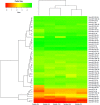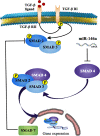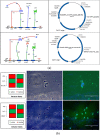Systems Studies Uncover miR-146a as a Target in Leishmania major Infection Model
- PMID: 32548436
- PMCID: PMC7271362
- DOI: 10.1021/acsomega.0c01502
Systems Studies Uncover miR-146a as a Target in Leishmania major Infection Model
Abstract
Leishmaniasis, the second most neglected tropical disease, has been reported to affect approximately 12 million people worldwide. The causative protozoan parasite Leishmania has shown drug resistance to available chemotherapies, owing to which we need to look for better approaches to deal with the clinical situations. As per recent reports, several miRNAs have been found to be differentially expressed during Leishmania major infection in host macrophages. We aim to evaluate the impact of miRNA-mediated gene regulation on the key players of inflammation and macrophage dysfunction. The origin of Leishmania miRNAs and their processing is a questionable phenomenon as of yet. Through our study, we aim to provide a framework of their characterization. We amalgamate chemical systems biology and synthetic biology approaches to identify putative miRNA targets and unravel the complexity of host-pathogen gene regulatory networks.
Copyright © 2020 American Chemical Society.
Conflict of interest statement
The authors declare no competing financial interest.
Figures









Similar articles
-
Leishmania (Leishmania) amazonensis induces macrophage miR-294 and miR-721 expression and modulates infection by targeting NOS2 and L-arginine metabolism.Sci Rep. 2017 Mar 9;7:44141. doi: 10.1038/srep44141. Sci Rep. 2017. PMID: 28276497 Free PMC article.
-
Identification and Characterization of miRNAs in Response to Leishmania donovani Infection: Delineation of Their Roles in Macrophage Dysfunction.Front Microbiol. 2017 Mar 2;8:314. doi: 10.3389/fmicb.2017.00314. eCollection 2017. Front Microbiol. 2017. PMID: 28303124 Free PMC article.
-
MicroRNA expression profiling of dibenzalacetone (DBA) treated intracellular amastigotes of Leishmania donovani.Exp Parasitol. 2018 Oct;193:5-19. doi: 10.1016/j.exppara.2018.07.018. Epub 2018 Aug 17. Exp Parasitol. 2018. PMID: 30125570
-
The role of heparan sulfate in host macrophage infection by Leishmania species.Biochem Soc Trans. 2018 Aug 20;46(4):789-796. doi: 10.1042/BST20170398. Epub 2018 Jun 22. Biochem Soc Trans. 2018. PMID: 29934302 Review.
-
Leishmania-macrophage interactions: insights into the redox biology.Free Radic Biol Med. 2011 Jul 15;51(2):337-51. doi: 10.1016/j.freeradbiomed.2011.05.011. Epub 2011 May 14. Free Radic Biol Med. 2011. PMID: 21620959 Review.
Cited by
-
Super enhancer-mediated transcription of miR146a-5p drives M2 polarization during Leishmania donovani infection.PLoS Pathog. 2021 Feb 25;17(2):e1009343. doi: 10.1371/journal.ppat.1009343. eCollection 2021 Feb. PLoS Pathog. 2021. PMID: 33630975 Free PMC article.
-
Investigation of the Expression Levels of miR-155, miR-133a, and miR-146b in the Serum of Acute and Chronic Forms of Cutaneous Leishmaniasis.Acta Parasitol. 2025 Aug 19;70(5):185. doi: 10.1007/s11686-025-01123-x. Acta Parasitol. 2025. PMID: 40828401
-
Comparative microRNA profiling of Trypanosoma cruzi infected human cells.Front Cell Infect Microbiol. 2023 Jun 21;13:1187375. doi: 10.3389/fcimb.2023.1187375. eCollection 2023. Front Cell Infect Microbiol. 2023. PMID: 37424776 Free PMC article.
-
Mechanobiology of immune cells: Messengers, receivers and followers in leishmaniasis aiding synthetic devices.Curr Res Immunol. 2022 Aug 23;3:186-198. doi: 10.1016/j.crimmu.2022.08.007. eCollection 2022. Curr Res Immunol. 2022. PMID: 36051499 Free PMC article. Review.
-
MicroRNAs: master regulators in host-parasitic protist interactions.Open Biol. 2022 Jun;12(6):210395. doi: 10.1098/rsob.210395. Epub 2022 Jun 15. Open Biol. 2022. PMID: 35702995 Free PMC article. Review.
References
LinkOut - more resources
Full Text Sources
Research Materials

